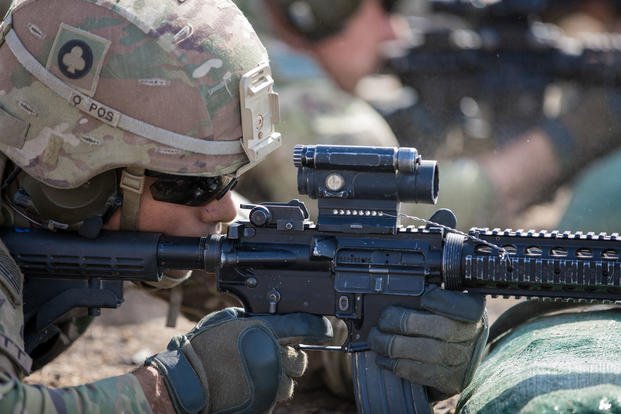Army infantry officials at Fort Benning, Georgia, are testing a handful of advanced fire control optics in an effort to one day help non-combat arms soldiers shoot more accurately against close-quarter and long-range enemy targets.
The effort is part of the Army Expeditionary Warfighting Experiments (AEWE) 2020 and will involve soldiers live-firing M4A1 carbines with fire control systems from three companies to see whether they can improve a shooter's probability of hitting targets faster than current Army-issue optics.
Currently, the service uses the M68 Close Combat Optic (CCO) and the M150 rifle Combat Optic (RCO). The CCO is an unmagnified, red dot sight designed for ranges out to 300 meters. The RCO has a 4X magnification for engagements out to 600 meters.
One of the Army's modernization priorities is to develop a Next Generation Squad Weapon that will replace the M4A1 and M249 squad automatic weapon in infantry and other close-combat units. Both weapons will be equipped with a fire control system that will calculate range to target and compensate with environmental conditions, such as wind, that can affect accuracy, service officials say.
Related: Army Wants to Replace Rifle Combat Optic with New Variable-Power Sight
The Army also announced in August that it's evaluating optics from seven vendors competing for the Direct View Optic (DVO) effort, a variable-power optic that will feature magnification settings from 1X to 6X compared to the 4X on the RCO.
Army officials at the Maneuver Battle Lab hope that commercial fire control systems being evaluated during the AEWE will help guide a future requirement for an advanced system to go to soldiers outside of combat-arms units.
"Everybody has got a weapon and everybody is required to hit targets, and anything we can do to make those populations better ... maybe we don't give them the latest and greatest, but we do want to give them capability," said Lt. Col. Chris Kennedy, chief of the Lethality Branch within Soldier Requirements Division at Maneuver Capabilities Development and Integration Directorate at Benning.
"Sometimes, those who shoot less actually might benefit the most from some of these devices," he added.
Soldiers from Fort Benning will evaluate the following fire controls during live-fire events scheduled to run until mid-December:
- FN America LLC's Modular Fire Control Unit (FCU), which includes a ballistic computer, range finder and aiming lasers. It is designed to work with a variety of day or night optics.
- Smart Shooter Inc.'s SMASH fire control, designed to automatically adjust the aim point for stationary and moving targets in daylight and limited visibility conditions. The SMASH has a red dot for rapid, close-quarters target engagements.
- Talon Expeditionary Services LLC's EX321 Ballistic Calculating Riflescope, which is equipped with variable magnification from 3X to 21X, a laser rangefinder, environmental sensors and ballistic calculator.
- Talon Expeditionary Services LLC's Precision Guided Firearms digital optic, which is equipped with variable magnification from 2X to 14X or 3X to 21X, laser rangefinder, environmental sensors and a ballistic calculator. It includes target tracking and predictive fire control designed to help shooters with engagements on stationary and moving targets.
"Instead of writing a Star Wars requirement that we may not see for 30 years, this is designed to tell us what is out there," Ed Davis, director of the Army Futures Command Battle Lab at Benning, told Military.com.
Army testers will collect data while soldiers shoot with the fire control systems at targets out beyond 300 meters as well as close-quarter targets inside 50 meters.
"Part of lethality is, if you can ballistically get on target faster than the enemy, you will probably win," Davis said. "We are [collecting] empirical data so we want to know how much better you are ... so we baseline against the CCO so we have some reference point to validate whether we are more accurate or not."
Once the AEWE concludes in March, the data on the fire controls will be put into a report to help guide the Requirements Division to develop a future requirement, Davis said.
"They will have some empirical data that they know is realistic to help scope where we are going to go forward," he said.
— Matthew Cox can be reached at matthew.cox@military.com.
Read more: Retired Air Force General Charged with Possession of Child Porn












